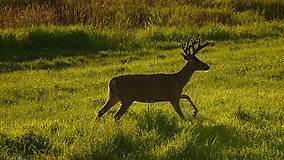Julia Butler Hansen Refuge for the Columbian White-Tailed Deer
Wildlife refuge in southwestern Washington and northwestern Oregon, US From Wikipedia, the free encyclopedia
Located in southwestern Washington and northwestern Oregon, United States, the Julia Butler Hansen Refuge for the Columbian White-Tailed Deer is a wildlife refuge. It was established in 1972 specifically to protect and manage the endangered Columbian white-tailed deer. The refuge contains over 5,600 acres (23 km2) of pastures, forested tidal swamps, brushy woodlots, marshes, and sloughs along the Columbia River in both Washington and Oregon.
| Julia Butler Hansen Refuge for the Columbian White-Tailed Deer | |
|---|---|
IUCN category IV (habitat/species management area) | |
 | |
| Location | Clatsop, Columbia counties, Oregon, Wahkiakum County, Washington, United States |
| Nearest city | Cathlamet, Washington |
| Coordinates | 46°14′50″N 123°24′49″W |
| Area | 5,600 acres (23 km2) |
| Established | 1972 |
| Named for | Julia Butler Hansen |
| Governing body | U.S. Fish and Wildlife Service |
| Website | Julia Butler Hansen Refuge |
Etymology and history
The refuge is named for Julia Butler Hansen, a former member of the United States House of Representatives for Washington state. Originally named the Columbian White-Tailed Deer Refuge, the name was changed in 1990.[1]
The refuge was specifically created to provide a protected habitat for endangered Columbian white-tailed deer. By 2015, the deer population in the Lower Columbia River region, which includes Julia Butler Hansen and the Ridgefield National Wildlife Refuge, had doubled to 900, allowing the species to receive a recommendation to be reclassified as threatened.[2] In April, 2012, a dike that keeps the Columbia River from flooding the Julia Butler Hansen Refuge collapsed during high river flow levels. The potential flood was considered a threat to the resident population of Columbian white-tailed deer.[3] A large portion of the deer population at the Ridgefield site is due to a relocation of deer from Julia Butler Hansen during the flood concerns.[2]
Habitat

The valuable habitat the refuge preserves for the deer also benefits a large variety of wintering birds, a small herd of Roosevelt elk, river otter, various reptiles and amphibians including painted turtles and red-legged frogs, and several pairs of nesting bald eagles and osprey.
Approximately 300 Columbian white-tailed deer live on the refuge per the last count. Another 300-400 deer live on private lands along the river. The areas upstream from the refuge on Puget Island and on the Oregon side of the river are vital to reestablishing and maintaining viable populations of the species. The refuge works with private and corporate landowners to maintain and reestablish deer on their lands.
References
Wikiwand in your browser!
Seamless Wikipedia browsing. On steroids.
Every time you click a link to Wikipedia, Wiktionary or Wikiquote in your browser's search results, it will show the modern Wikiwand interface.
Wikiwand extension is a five stars, simple, with minimum permission required to keep your browsing private, safe and transparent.


